Planter Box Fabric: Key to Sustainable Gardening
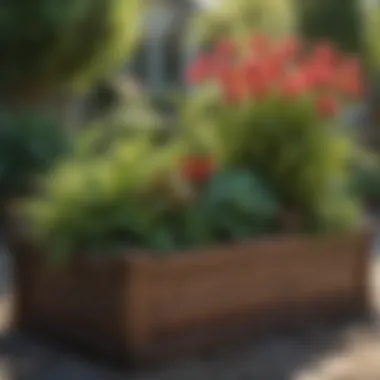
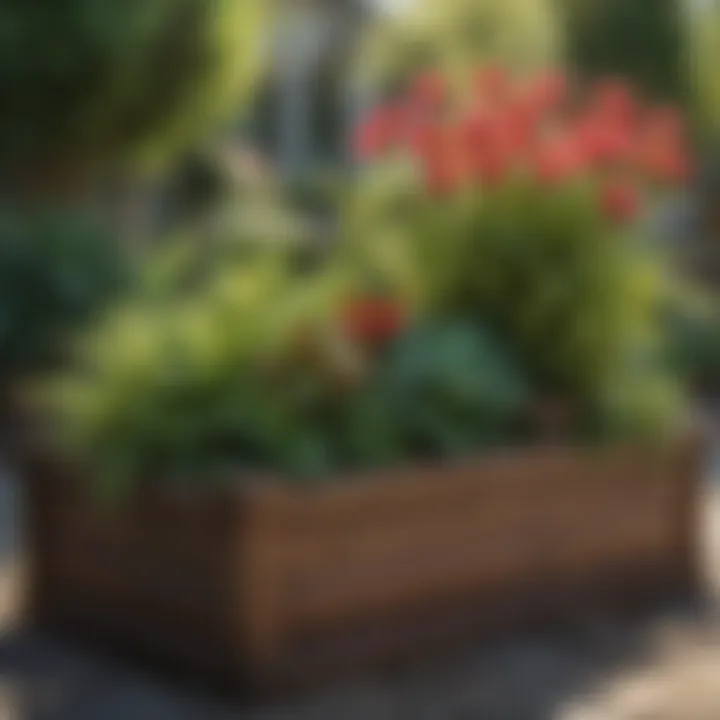
Intro
The role of planter box fabric in sustainable gardening is often overlooked, despite its essential contribution to the health of plants and the preservation of resources. This article explores the various facets of planter box fabric, from its definition and significance to its practical applications. With a growing emphasis on eco-friendly practices in agriculture, understanding the materials and innovations surrounding planter box fabric becomes crucial for enthusiasts and farmers alike.
Topic Overview
Definition and Importance
Planter box fabric is a specialized material designed to support plants' growth in contained environments. It provides a barrier that promotes air circulation, drainage, and root health. This fabric plays a vital role in preventing soil erosion and ensuring that the nutrients within the soil are preserved, ultimately leading to healthier plant growth. In sustainable gardening, the selection of the right fabric can significantly impact the overall efficiency and success of the gardening process.
Brief History and Evolution
Historically, the use of fabrics in gardening can be traced back to ancient agricultural practices. Early farmers used natural fibers such as burlap to create barriers for plants. However, the modern version of planter box fabric has evolved considerably. Today, various synthetic and organic materials are employed to enhance durability, functionality, and beneficial properties. This evolution reflects advancements in both textile science and agricultural practices.
Key Techniques and Innovations
Sustainable Farming Practices
The integration of planter box fabric aligns with many sustainable farming practices. It aids in water conservation by reducing runoff and evaporation. Furthermore, using naturally biodegradable fabrics, like jute, contributes to less landfill waste. These practices promote a circular economy in gardening, making it easier to re-use materials when they reach the end of their life cycle.
Advanced Agronomic Technologies
Recent innovations in agronomy have led to the development of specialized planter box fabrics. Some fabrics now incorporate features such as water retention properties and additives that repel pests. This emphasizes the ongoing trend toward more effective gardening solutions that benefit both the environment and individuals involved in agriculture.
Practical Applications
Step-by-Step Guides
- Assess Your Garden Size: Determine the appropriate size of your planter box based on available space.
- Select the Right Fabric: Choose fabrics that suit the environmental conditions of your area, considering factors like moisture and temperature.
- Prepare the Area: Clear the chosen space, ensuring it is level and free from debris.
- Install the Fabric: Lay the fabric across the box, ensuring it covers the bottom and sides adequately to prevent soil loss while allowing for drainage.
- Fill With Soil: Add the appropriate mix of soil, compost, and nutrients before planting.
- Regular Maintenance: Monitor the fabric for wear and tear, replacing it as necessary.
Case Studies or Real-World Examples
- Community Gardens: Many community gardens utilize planter box fabric to create small, productive spaces within urban environments. By employing this technique, they have improved yield and reduced environmental impact.
- Vertical Gardening Projects: In cities, vertical gardens utilizing planter box fabric have gained traction. These systems maximize limited space and allow for diverse plant varieties, showcasing innovative gardening methods.
"The choice of planter box fabric significantly affects the sustainability and productivity of any gardening endeavor."
Understanding the properties of various fabrics and their applications can lead to a more sustainable and productive gardening experience. As the agricultural landscape continues to shift toward sustainable practices, knowing how to effectively use planter box fabric will be increasingly paramount for both farmers and gardening enthusiasts.
Prelims to Planter Box Fabric
The role of planter box fabric in gardening gains significant attention due to its considerable benefits in sustainable practices. Understanding its definition and purpose lays the groundwork for evaluating its impact on gardening. Planter box fabric contributes not only to the aesthetic aspect of gardening, but also provides functional advantages essential for plant health.
Definition and Purpose
Planter box fabric refers to specific materials used to line planter boxes. This fabric allows for appropriate water drainage while retaining soil, which is critical for the growth of plants. By creating a barrier between the soil and the box, this material helps prevent soil erosion and nutrient loss. Furthermore, it acts as a protective layer, minimizing damage from pests and diseases.
Home gardeners and agricultural enthusiasts can select different types of fabrics based on their needs, considering factors such as moisture control and temperature regulation. The right fabric not only enhances the efficiency of the planter but also contributes to the overall health of the plants.
Importance in Sustainable Gardening
The importance of planter box fabric in sustainable gardening cannot be overstated. It plays a crucial role in promoting healthy plant growth while minimizing resource usage. By using materials that allow for adequate drainage, the fabric reduces the risk of overwatering, which can lead to root rot and other complications.
Utilizing such fabrics can lead to better soil retention, especially in urban gardening where soil quality might be variable. The use of planter box fabric assists in maintaining a stable environment for plant roots, which is vital for nutrient absorption. Additionally, the right fabric can significantly reduce the need for chemical fertilizers and pesticides, aligning with sustainable gardening principles.
"The choice of planter box fabric is vital for creating a sustainable gardening environment that nurtures both plants and the ecosystem."
This introduction sets the stage for a deeper exploration of the various types, benefits, and innovations related to planter box fabric, which will enhance understanding and encourage sustainable gardening practices.
Types of Planter Box Fabric
Planter box fabric serves a significant purpose in sustainable gardening. It can affect various aspects such as plant health, soil retention, and moisture management. Understanding the types of planter box fabric available is essential for making informed choices that align with sustainability goals. There are two primary categories of planter box fabric: natural fabrics and synthetic fabrics. Each has its unique properties, advantages, and specific applications that resonate with distinct gardening needs.
Natural Fabrics
Natural fabrics are derived from renewable resources, providing eco-friendly options for gardeners. They offer several benefits, such as biodegradability and being free from synthetic chemicals.
Jute
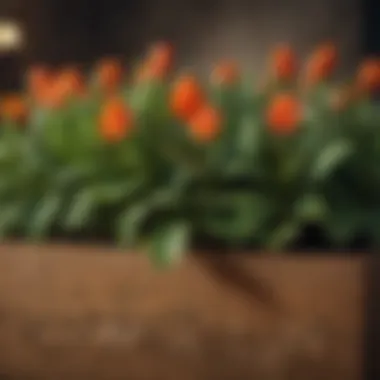
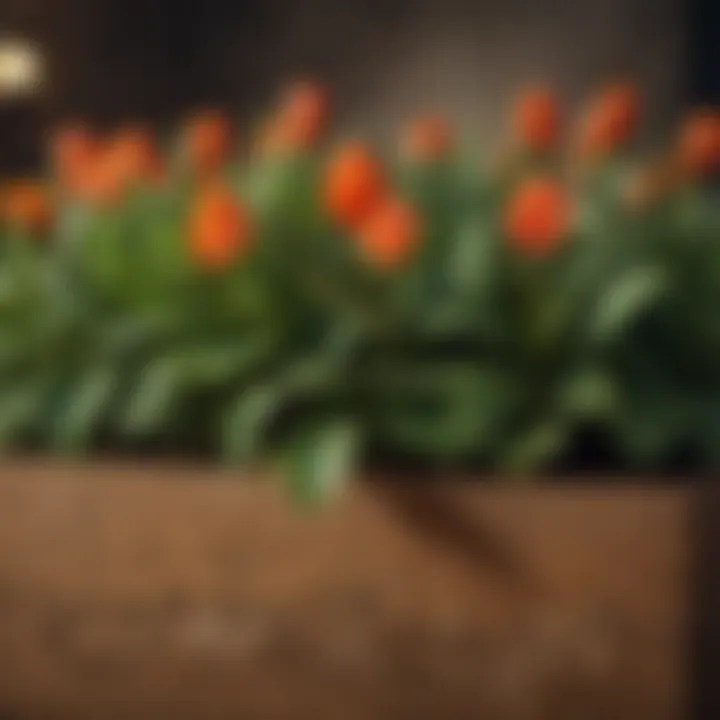
Jute is known for its robust and eco-friendly nature. It is a popular choice among gardeners for planter boxes owing to its excellent breathability. This property allows air and moisture to circulate freely, which is vital for healthy root growth. Jute's unique feature is its ability to decompose over time, improving the soil structure and enriching it with organic material as it breaks down.
Moreover, jute is lightweight and easy to handle, making it a convenient option for various gardening applications. However, one disadvantage is its lower moisture retention compared to some synthetic options, meaning it may require more frequent watering in dry conditions.
Cotton
Cotton is another natural fabric that finds its use in gardening. Its main characteristic is softness and flexibility, allowing it to conform easily to the planter's shape. Cotton provides good drainage and is capable of handling moisture well, which helps in preventing root rot.
One unique feature of cotton is that it is breathable, allowing excess heat and moisture to escape. However, its durability can be a concern as it may degrade fast when exposed to elements like sunlight and water for long periods. Hence, it may not be ideal for all gardening scenarios, particularly in harsh weather.
Synthetic Fabrics
Synthetic fabrics have gained popularity for their durability and resistance to various environmental conditions. They are often designed to enhance gardening efficiency by providing robustness and longevity.
Polypropylene
Polypropylene is a widely used synthetic fabric known for its strength and resistance. This fabric is highly durable, which makes it a favored choice for planter boxes. Polypropylene resists moisture and decay, suitable for prolonged use in outdoor environments. Its unique feature lies in its ability to retain soil without allowing it to seep out, making it effective for soil retention.
However, while polypropylene is excellent in terms of durability, it is less biodegradable than natural options. This means it may contribute to plastic waste unless recycled properly.
Geotextiles
Geotextiles are specialized fabrics designed to improve drainage and control erosion. One key characteristic of geotextiles is their ability to separate, filter, and reinforce soil. They can support the planter's structure while promoting water and air movement through the fabric.
Geotextiles are advantageous because they are often made from recycled materials, adding an eco-friendly aspect to their use. However, their effectiveness can vary, and careful selection is essential to ensure compatibility with specific gardening applications.
Assessing Durability
Assessing the durability of planter box fabric is crucial in ensuring effective and sustainable gardening practices. Durability affects not only the performance of the fabric but also the overall health of the plants. A fabric that breaks down quickly or fails to retain soil or moisture can lead to compromised growth conditions. Therefore, understanding the factors that influence durability is essential for gardeners looking to maximize their gardening success.
Factors Influencing Durability
Material Quality
Material quality is one of the most significant factors influencing the durability of planter box fabric. High-quality materials resist wear and tear, making them a reliable choice for prolonged use. For instance, natural fibers like jute tend to break down faster than synthetic options, but they are biodegradable, which may benefit organic gardening. Conversely, polypropylene is strong and lasts longer, providing excellent resistance to environmental stressors. Planting enthusiasts must consider what matches their gardening approach better.
Unique to material quality is the characteristic of breathability. A good fabric allows air to circulate while maintaining moisture, vital for healthy plant roots. Higher quality materials tend to balance these aspects better, thus enhancing their utility in various climates and conditions. The downside may be cost; some may find high-quality materials more expensive but worth the investment in the long run.
Environmental Conditions
The environment where the planter box fabric is used plays a vital role in determining its durability. Factors such as sunlight exposure, moisture levels, and temperature fluctuations can degrade fabrics over time. Fabrics exposed to intense sunlight may fade and weaken, leading to faster deterioration. On the other hand, environments with high humidity can foster mold and mildew growth, compromising the fabric's integrity.
One unique consideration is the impact of temperatures. Fabrics that can withstand extreme conditions offer gardeners more versatility. However, if a fabric is not designed for specific environmental challenges, it may lead to premature replacement. Gardeners need to assess their local conditions and choose fabrics engineered for those challenges to extend lifespan and functionality.
Expected Lifespan
Understanding the expected lifespan of different planter box fabrics helps in making informed choices. Generally, natural fabrics can last a couple of years under ideal conditions, while synthetic options may endure up to five years or more, depending on the quality and care.
Gardening enthusiasts should regularly monitor the condition of their fabrics. Regular checks for fraying, tearing, or degradation will allow timely interventions, like replacement or maintenance, to ensure that the fabric continues to support plant growth effectively.
"Choosing the right fabric not only extends its life but significantly impacts plant health and growth."
The assessment of durability in planter box fabrics serves as a pivotal consideration for any gardener aiming to create a sustainable gardening practice.
Benefits of Using Planter Box Fabric
The utilization of planter box fabric offers numerous advantages for both novice and experienced gardeners. Using the right fabric enhances the gardening experience while significantly contributing to sustainable practices. The benefits extend beyond aesthetics; they provide practical solutions to common gardening challenges. Here, we explore three pivotal benefits: soil retention, weed control, and improved drainage.
Soil Retention
One of the primary advantages of using planter box fabric is its ability to retain soil effectively. The fabric acts as a barrier, reducing the risk of soil erosion, particularly in elevated gardening setups. This is important for maintaining soil health, as it minimizes the loss of nutrients that are essential for plant growth.
Additionally, the fabric can prevent soil compaction. When soil is compacted, air and water flow become restricted, making it difficult for roots to thrive. With the right planter box fabric, soil structure improves, allowing for better aeration and moisture retention.
"Soil retention is crucial for sustainable gardening, as it ensures that vital nutrients remain available for plants."
Weed Control
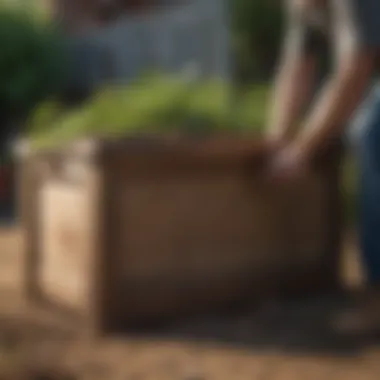
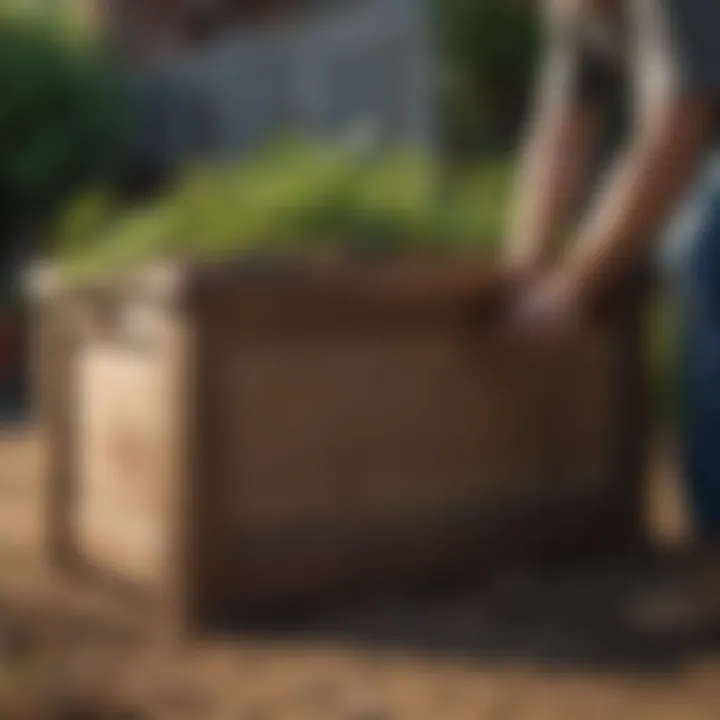
Weeds can be a persistent annoyance in any garden. Planter box fabric provides an effective method to combat these unwanted plants. The fabric serves as a physical barrier that inhibits weed growth by blocking sunlight, which is necessary for their germination and development.
While some weeds may still find a way through the fabric, the overall weed population is significantly reduced. This advantage means less time spent weeding and more time dedicated to nurturing desirable plants. Moreover, using fabric aligns with sustainable gardening practices, as it reduces the need for chemical herbicides that can be harmful to the environment.
Improved Drainage
Another critical benefit of planter box fabric is its ability to enhance drainage. Many plants thrive in well-draining soil, and excessive water can lead to root rot or other water-related issues. Planter box fabrics, especially those made from materials designed for drainage, allow excess water to escape while holding in sufficient moisture for plant needs.
This aspect is particularly vital in regions with heavy rainfall or for gardeners using containers that can retain too much water. Improved drainage leads to healthier root development, which in turn supports better plant growth. By keeping the roots healthy, gardeners can increase yields and improve the overall productivity of their gardening endeavors.
The benefits of using planter box fabric go a long way in ensuring that sustainable gardening practices are not only achievable but also effective. The combination of soil retention, weed control, and improved drainage provides a solid foundation for healthy plants, allowing gardeners to focus on what they love—growing.
Installation Techniques
Installation techniques are a crucial aspect of utilizing planter box fabric effectively in sustainable gardening. Proper installation not only enhances the functionality of the planter but also ensures the longevity of both the fabric and the plants. Additionally, the techniques applied can significantly influence the overall health of the plants and the efficiency of water usage.
Preparing the Planter Box
Before installing the planter box fabric, careful preparation of the planter box itself is essential. The first step involves selecting a suitable location. Consider factors such as sunlight exposure, drainage potential, and proximity to water sources. Once the location is determined, the planter box should be cleaned thoroughly to remove any debris or remnants from previous use. This ensures a sterile environment for the new plants to thrive.
Next, measure the dimensions of the planter box accurately. This step is vital, as any miscalculation can lead to inadequate coverage or excess fabric that might hinder proper drainage. Once the dimensions are established, cut the fabric to size, allowing for some overlap at the edges to secure it firmly later.
Some additional considerations in this step are:
- Soil Type: Choose the right type of soil suitable for the plants you plan to grow. This should be done before the fabric is laid down.
- Drainage Holes: Ensure that the planter box has enough drainage holes. This is necessary to prevent water accumulation that can lead to root rot.
- Weed Barrier: If the planter box is placed on the ground, consider adding a layer of landscape fabric under the planter box fabric to prevent weeds from growing up through it.
Securing the Fabric
Securing the planter box fabric is another important step to ensure its functionality and longevity. The fabric should be attached in a manner that allows it to perform its role effectively. One common method is to use staples or landscape fabric pins to secure the edges of the fabric. The fabric should be stretched tautly across the surface of the planter box to prevent sagging. Unsecured fabric can trap water and lead to deterioration.
After laying the fabric, make sure it covers all sides of the planter box. This creates a barrier that helps with soil retention, limits weed growth, and maintains moisture levels.
The successful installation of planter box fabric contributes to a healthier growing environment.
In addition to using staples, you may also consider using weights or anchors, especially in elevated or windy areas, to secure the fabric. For some gardeners, cutting small slits for planting may be preferred.
Finally, once everything is secured, add the soil and desired plants on top of the fabric, ensuring the fabric does not interfere with root growth or plant development. Proper installation techniques can make a significant impact on the success of the gardening efforts.
Maintenance of Planter Box Fabric
Maintaining planter box fabric is crucial for ensuring its longevity and effectiveness in sustainable gardening. Proper care enhances soil health, promotes better drainage, and reduces the risk of disease in plants. Without regular maintenance, the fabric can degrade quickly, undermining the investment made in these eco-friendly gardening solutions. Therefore, understanding the best cleaning techniques and knowing when to replace the material are necessary to maximize the benefits of using planter box fabric.
Cleaning Techniques
Cleaning planter box fabric should be part of a regular maintenance routine. Here are effective methods to keep the fabric in optimal condition:
- Rinse with Water: Periodically, rinse the fabric with a garden hose. This process helps remove dust, soil remnants, and any decomposing organic matter that may accumulate.
- Use Mild Detergents: If the fabric shows signs of mildew or stubborn stains, a mild detergent mixed with water can help. Avoid harsh chemicals, as they may damage the fabric. Gently scrub using a soft brush to dislodge any buildup.
- Dry Thoroughly: After cleaning, allow the fabric to dry completely before reusing it. This step is essential to prevent mold growth. Hanging the fabric in a well-ventilated area or laying it flat under the sun works efficiently.
Replacement Guidelines
The time to replace planter box fabric will depend on several factors, including the type of material, exposure to elements, and usage frequency. Here are signs to help determine when it’s time to replace the fabric:
- Visible Fraying or Tears: Inspect the fabric regularly. Signs of wear, such as frayed edges or tears, can severely impact its function and may indicate the need for replacement.
- Loss of Shape or Structure: If the fabric has lost its form and no longer holds soil properly, replacing it is a good idea. A properly structured fabric is vital for effective drainage and support for plants.
- Decomposition: With organic fabrics, discoloration or a breakdown in integrity signals the end of its usefulness.
"Regular maintenance not only prolongs the life of planter box fabric but also significantly contributes to the health of your plants."
Environmental Impact
The environmental impact of planter box fabric is a crucial topic within sustainable gardening. Its implications extend to various areas of gardening practice, including materials sourcing, waste management, and overall ecological footprint. Understanding these factors is essential for farmers and gardening enthusiasts looking to make informed choices that benefit the planet.
Sustainable Sourcing
Sustainable sourcing refers to the practice of selecting materials that have been produced and harvested with minimal negative effects on the environment. In the context of planter box fabric, this can include the use of organic materials or those that are readily renewable. For instance, fabrics derived from jute or cotton can be sourced from farms that utilize environmentally friendly farming techniques, reducing chemical use and promoting soil health.
The choice of materials not only affects the environmental impact during production but also plays a role in the longevity and recyclability of the planter box fabric. Fabrics that decompose naturally, such as those made from biodegradable fibers, contribute less waste to landfills and can enhance soil fertility as they break down. Proper audits and certifications, such as Global Organic Textile Standard (GOTS) or OEKO-TEX certification, can guide consumers toward more responsible options.
Waste Reduction Strategies
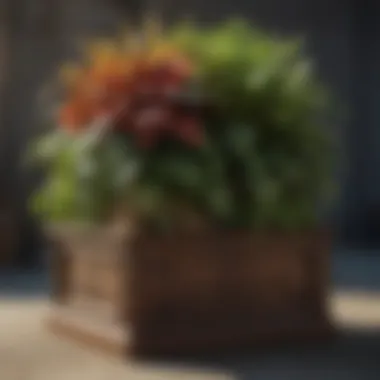
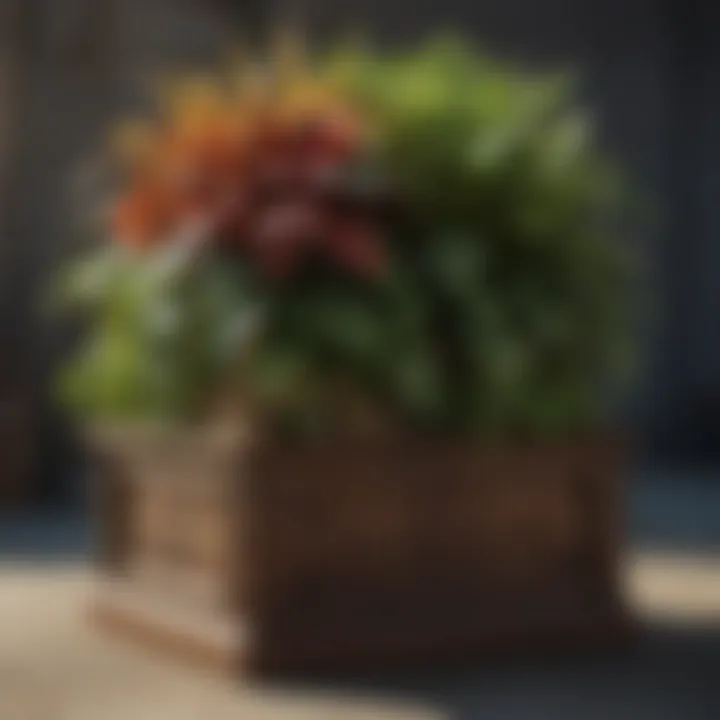
Waste reduction strategies are vital for promoting a sustainable approach to gardening. Using planter box fabric can significantly minimize the disposal of traditional planting solutions, such as plastic or non-biodegradable materials. Here are some effective strategies to consider:
- Composting Fabric: Fabrics made from natural fibers can be composted after their useful life, returning nutrients to the soil.
- Repurposing: After their initial use, many planter box fabrics can be repurposed for other gardening tasks, like weed barriers or temporary plant covers.
- Choosing Durable Materials: Selecting high-quality, durable fabrics reduces the frequency of replacements, thus decreasing waste.
Implementing these strategies not only supports the reduction of waste in gardening practices but also aligns with the broader efforts toward achieving zero waste in agricultural systems.
Minimizing waste through responsible practices is essential for sustainable gardening and preserving our natural ecosystem.
Choosing Suitable Plants for Fabric Planters
Choosing the right plants for fabric planters is critical for successful gardening. Fabric planters provide unique conditions that differ from traditional pots. Therefore, selecting plants that thrive in these environments enhances growth and sustainability. This section highlights key benefits and considerations when selecting suitable plants for fabric planters.
Vegetables and Herbs
Vegetables and herbs are excellent choices for fabric planters. They benefit from the enhanced drainage and aeration that fabric pots offer. The breathable nature allows roots to grow healthier and can prevent overwatering, a common issue in traditional plastic pots.
When choosing vegetables, consider those with compact growth habits. Examples like cherry tomatoes, radishes, and lettuce work well in fabric planters. They adapt to the moisture levels available within the fabric, leading to thriving growth. Additionally, herbs such as basil, parsley, and mint also flourish in these conditions. They require good drainage, which fabric planters easily provide.
Some considerations for vegetables and herbs include:
- Space requirements: Ensure you select plants that will not overcrowd each other as they grow.
- Water needs: Be aware of the watering frequency required for your chosen plants.
- Temperature tolerance: Some plants prefer cooler conditions while others thrive in heat.
Flowers and Ornamental Plants
For those interested in aesthetics, flowers and ornamental plants enhance the visual appeal of any garden space. Fabric planters support a variety of flowering plants. Petunias, marigolds, and impatiens do well in these containers. The growth environment promotes healthy flowering cycles and vibrant colors.
Ornamental plants such as ferns and succulents also do particularly well in fabric planters. Their rooting systems benefit from dry soil conditions that fabric can provide. For instance, succulents like Echeveria or Haworthia prefer drier conditions, making the breathable fabric an ideal selection.
Key points while selecting floral and ornamental plants involve:
- Light requirements: Different plants have varying light needs. Make sure they align with your garden's light exposure.
- Growth rate: Ensure that you consider how quickly the plant will grow and fill the space available.
- Height and spread: Choose plants that will complement each other in size and appearance.
"The choice of plants suitable for fabric planters is not just about what looks good. It’s about the conditions that affect growth and sustainability."
Selecting appropriate plants enhances not only the performance of your garden but also its sustainability. This choice engages and aligns with broader gardening practices that emphasize environmental responsibility.
Current Innovations in Planter Box Fabric
The evolution of planter box fabric is marked by innovative developments that respond to the specific needs of sustainable gardening. As more gardeners prioritize eco-friendliness and efficiency, the market sees an increasing array of advanced materials and technologies. This section discusses how these innovations enhance functionality, sustainability, and overall gardening success.
Biodegradable Options
As the planet faces significant environmental challenges, the demand for biodegradable materials is growing. Biodegradable planter box fabrics break down naturally in the soil, reducing the ecological impact once they have served their gardening purpose. This great advancement aligns perfectly with sustainable gardening principles.
Some common materials used for biodegradable options include:
- Jute: A natural fiber that is strong yet decomposes over time, allowing nutrients to be released back into the soil.
- Cotton: Another natural fiber that can decompose, offering a sustainable choice for planting.
When using biodegradable fabrics, the gardener should consider their lifespan in relation to the plants being grown. Certain crops may benefit from the slow breakdown, as it can improve soil health and structure. However, quicker-growing plants may require more durable fabrics. Ultimately, the choice hinges on understanding the specific growth cycles involved.
Smart Fabrics with Moisture Sensors
Technological advancements have led to the development of smart planter box fabrics equipped with moisture sensors. These revolutionary products actively monitor soil moisture levels and adjust to the plant's needs.
The integration of moisture sensors into planter box fabric offers multiple benefits:
- Water Conservation: Results from sensors help reduce water waste by providing in-time feedback, ensuring plants get just enough moisture without excess saturation.
- Healthier Plants: When soil moisture levels are optimal, plants grow stronger and healthier, reducing the need for chemical interventions.
- Ease of Use: These fabrics provide users with real-time data, simplifying gardening for both amateurs and seasoned gardeners.
In summary, current innovations in planter box fabric, such as biodegradable options and smart fabrics, highlight a significant shift towards sustainable practices. These elements not only improve plant growth but also address environmental concerns effectively.
The End and Future Directions
Summary of Key Points
The article has examined several key points regarding planter box fabric:
- Definition and Purpose: Understanding what planter box fabric is and why it is essential for gardening.
- Types of Fabrics: Differentiating between natural fabrics like jute and synthetic options such as polypropylene.
- Benefits: Highlighting how these fabrics improve soil retention, control weeds, and enhance drainage.
- Installation Techniques: Providing guidance on how to install planter box fabric effectively.
- Environmental Impact: Considering the fabric's sustainability and its role in waste reduction.
- Innovations: Exploring the advancements in fabric technologies, including biodegradable and smart fabrics.
These points illustrate not only the practical applications but also the broader environmental considerations that come with using planter box cloth. They encourage readers to optimize their gardening efforts while being mindful of ecological implications.
Potential for Advancements
Looking to the future, the potential for advancements in the field of planter box fabrics is substantial. Innovations in material science may lead to increased durability, enhanced biodegradability, and even smart features like moisture sensors integrated into the fabric itself. Such developments will not only elevate the efficacy of these materials but also promote better ecological practices among gardeners.
Research advancements could yield fabrics made from more sustainable sources, further encouraging a shift toward environmentally friendly gardening solutions. As interest in sustainable agriculture continues to grow, the demand for smarter, more efficient planter box fabrics will likely lead to more robust solutions that not only satisfy practical gardening needs but also cater to environmental concerns.
Overall, as gardeners and farmers become more aware of their environmental footprint, the relevance of informed choices regarding planter box fabric will become paramount. The industry stands on the brink of significant transformation, urging both enthusiasts and professionals to look closely at how these advancements can work together with sustainable gardening principles.



